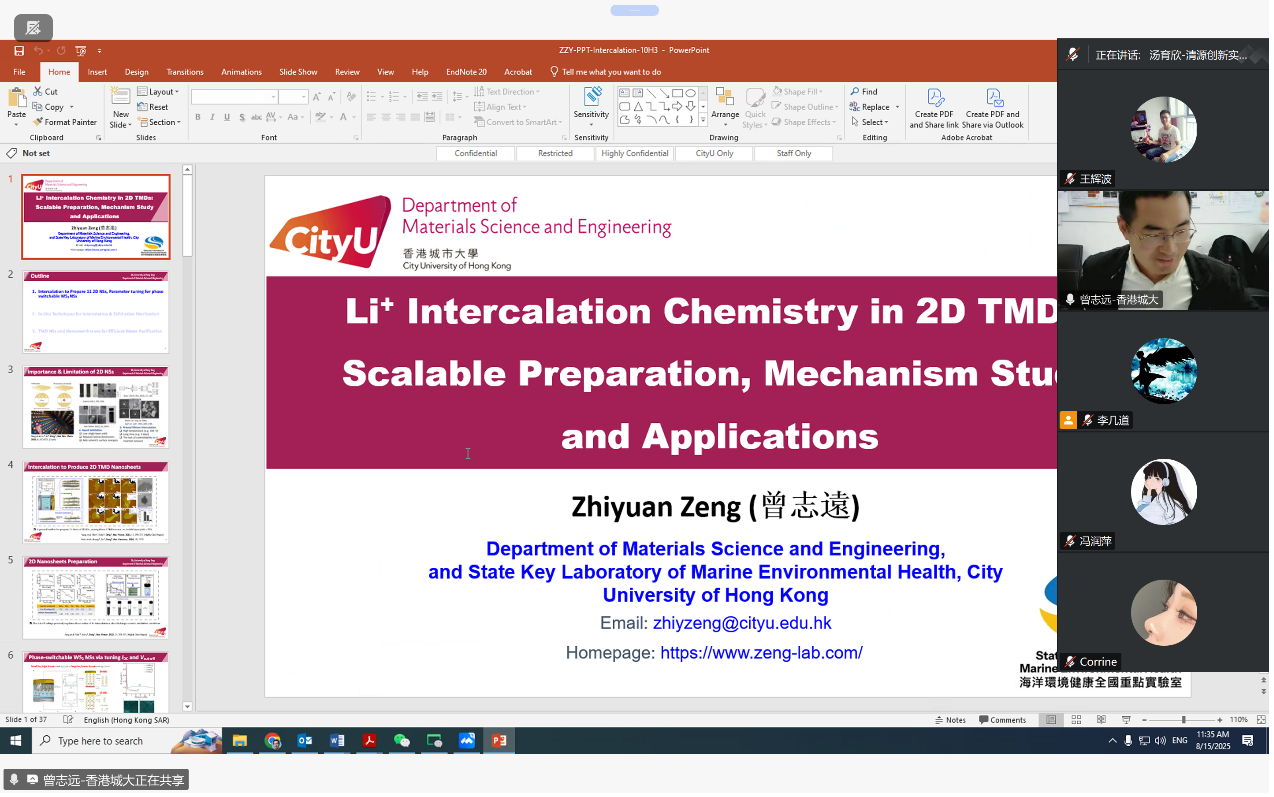On the morning of August 15, 2025, at the invitation of Professor Tang Yuxin from the School of Chemical Engineering of our university, Professor Xing Guichuan from the University of Macau and Professor Zeng Zhiyuan from City University of Hong Kong delivered wonderful online academic reports to teachers and students.
1. Professor Xing Guichuan from the University of Macau gave an online thematic academic report titled "Room-Temperature Coherent Optical Phonons with Lifetime in Perovskite Nano-superlattices".
The development of high-efficiency, stable, and low-cost optoelectronic materials and devices is a crucial approach to achieving efficient energy utilization and collection, as well as a key support for promoting China's transition to a low-carbon economy. Metal halide perovskites combine the advantages of inorganic and organic materials, showing broad prospects in low-cost, large-area, flexible optoelectronic devices such as lighting and light-harvesting applications. The core of the operation of perovskite optoelectronic devices lies in the dynamic behavior of carriers in the functional layer under the action of light/electric fields. Therefore, regulating the dimension and size of materials to realize the detection, understanding, and regulation of carrier dynamics has become a core scientific issue in this field. This report systematically introduced the research progress made by the research group in aspects such as the excellent luminescent properties of metal halide perovskites, the detection and regulation of carrier dynamics, the performance optimization of solar cells and light-emitting devices, and the expansion of new luminescent applications.
Starting from his own scientific research experience, Professor Xing Guichuan vividly explained how to elevate personal interests into systematic and in-depth scientific exploration, and focused on sharing his insights and cases of achieving key breakthroughs through the integration of interdisciplinary thinking in his research. In the report, he systematically analyzed the latest discoveries of coherent phonon behavior in perovskite materials from a forward-looking perspective. His innovative perspective across physics, chemistry, and materials engineering stimulated in-depth thinking and extensive discussions among teachers and students. In the communication session, the participating teachers and students conducted dialogues around cross-scale mechanisms in optoelectronic-energy materials and the integration of interdisciplinary methods, realizing the collision and reconstruction of knowledge structures in multiple fields.
This activity effectively promoted the in-depth integration of multiple disciplines such as optoelectronics, chemistry, materials, and engineering applications by facilitating the exchange of interdisciplinary ideas, and provided an important opportunity for building a collaborative and innovative scientific research paradigm.

Lecture scene
2. Professor Zeng Zhiyuan from City University of Hong Kong gave an online academic report titled "Lithium Intercalation Technology for Two-Dimensional Materials: Preparation, Mechanism and Applications".
Atom/ion intercalation is an effective means to regulate the physical and chemical properties of two-dimensional (2D) materials. Professor Zeng's team has developed a precisely controllable Li⁺ intercalation and exfoliation technology, which enables the efficient preparation of 11 types of 2D transition metal dichalcogenides (including MoS₂, WS₂, TiS₂, etc.), among which the yield of single-layer/double-layer nanosheets for three of these materials exceeds 90%. By precisely controlling the amount of lithium intercalation and the termination potential, this technology effectively suppresses the occurrence of side reactions. Moreover, through adjusting the current density and cut-off voltage, it can realize the controllable preparation of 2H-phase and 1T'-phase WS₂ nanosheets.
In terms of mechanism research, the team independently developed a new type of electrochemical chip, which significantly improved the spatial resolution of in-situ liquid-phase transmission electron microscopy (TEM). For the first time, it realized nanoscale visualized observation of interface processes such as solid electrolyte interphase (SEI) film formation, lithium dendrite growth, and dynamic self-healing of LiF nanocrystals, providing direct experimental evidence for understanding the electrochemical solid-liquid interface reactions. Combined with a variety of in-situ spectroscopic techniques, the team systematically clarified the mechanism of Li⁺ intercalation behavior, laying a foundation for mass production.
In the application aspect, the 1T/1T'-phase transition metal dichalcogenide (TMD) nanosheets developed by the team show outstanding performance in water purification technology, with an adsorption capacity for Pb²⁺ as high as 758 mg g⁻¹. The treatment capacity of their MoS₂ membranes is significantly better than that of conventional materials. The capacitive deionization system constructed based on 1T'-phase MoS₂ membranes has a volumetric desalination capacity of 65.1 mg NaCl cm⁻³. Meanwhile, the nanolaminated membranes prepared by covalent functionalization exhibit rejection rates of over 90% for dyes and over 80% for salts in reverse osmosis tests, demonstrating excellent application prospects in water treatment.
Through his personal scientific research experience, Professor Zeng Zhiyuan vividly demonstrated the transition path from basic research to technological innovation, and his interdisciplinary research methods provided important inspiration for the participating teachers and students. This report effectively promoted the in-depth intersection and innovative integration of multiple disciplines such as materials science, chemistry, and environmental science.

Lecture scene
